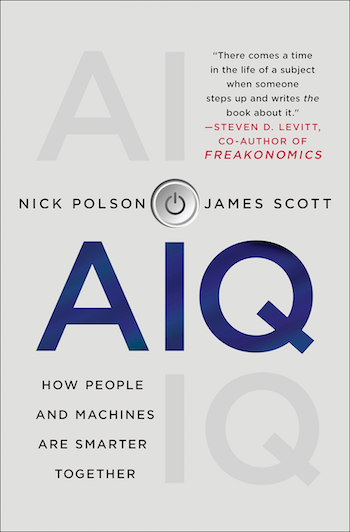AIQ

AIQ: How People and Machines Are Smarter Together, by Nick Polson and James Scott
St. Martin’s Press (2018)
Amazon - Barnes and Noble - IndieBound - Powell’s
From the jacket:
AIQ is based on a simple premise: if you want to understand the modern world, then you have to know a little bit of the mathematical language spoken by intelligent machines. AIQ will teach you that language―but in an unconventional way, anchored in stories rather than equations.
My co-author Nick Polson and I first thought of this book as a way to answer all the great questions our students had about artificial intelligence: how does a self-driving car work, how does Alexa understand what I’m saying, that sort of thing. We noticed that there was a lot of writing about AI that was very technical, a lot that was borderline science-fiction (“the robots are coming for you!”), and a lot that was pop sociology – but that if you wanted a non-technical version of how this stuff actually works, or sometimes doesn’t work, you were stuck.
But then along the way, we realized that the public narratives surrounding AI were pretty broken. On the one hand, you have this incredible amount of hype from people in the business world. Companies are buying ads during the Super Bowl touting AI, they’re hanging billboards from the rafters of airports —- and they’re all claiming that AI is going to fix the health care system and sell more widgets and make your toilet smell like roses. On the other hand, you have folks claiming that AI is going to destroy everything we care about, from our jobs to our privacy to our democracy.
With AI, we’ve clearly reached the point where a non-expert can’t tell the difference between the hype and the reality. So as educators, Nick and I came back to a simple bedrock: it’s really important for people to have a sense of what’s hot air and what’s genuine promise; what’s sci-fi dystopia and what’s a real policy issue. People can’t do that without understanding how AI really works. Hence AIQ.
Praise for AIQ
Steven D. Levitt, co-author of Freakonomics:
“There comes a time in the life of a subject when someone steps up and writes the book about it. AIQ explores the fascinating history of the ideas that drive this technology of the future and demystifies the core concepts behind it; the result is a positive and entertaining look at the great potential unlocked by marrying human creativity with powerful machines.”
Michael J. Casey, Author of The Age of Cryptocurrency and The Truth Machine:
“Nick Polson and James Scott take us under the hood of AI and data science, showing that behind most algorithms is the story of a person trying to solve a problem and make the world better. The result is an engaging, optimistic vision of an age in which computers have become a pervasive, influential presence in every aspect of life.”
David Spiegelhalter, Professor of the Public Understanding of Risk at the University of Cambridge:
At last, a book on the ideas behind AI and data science by people who really understand data. Cutting through the usual journalistic puff and myths, they clearly explain the underlying ideas behind the way that masses of data are being harnessed to build the algorithms that can carry out such extraordinary feats. But they are also clear about the limitations and potential risks of these algorithms, and the need for society to scrutinise and even regulate their use. A real page-turner, with fine stories and just enough detail: I learned a lot.
Data Science: A Gentle Introduction
I’m currently revising a textbook on data science. Right now this available as the course packet to my STA 371H course, but it will soon be a book.
Articles and commentary
Commentary: Sweden Actually Protects its Residents’ Data. America Should Take Note.. Fortune, April 13, 2018.